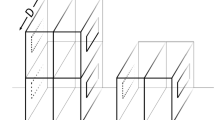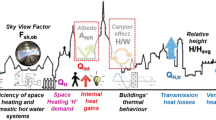Abstract
A scheme that couples a detailed building energy model, EnergyPlus, and an urban canopy model, the Town Energy Balance (TEB), is presented. Both models are well accepted and evaluated within their individual scientific communities. The coupled scheme proposes a more realistic representation of buildings and heating, ventilation and air-conditioning (HVAC) systems, which allows a broader analysis of the two-way interactions between the energy performance of buildings and the urban climate around the buildings. The scheme can be used to evaluate the building energy models that are being developed within the urban climate community. In this study, the coupled scheme is evaluated using measurements conducted over the dense urban centre of Toulouse, France. The comparison includes electricity and natural gas energy consumption of buildings, building façade temperatures, and urban canyon air temperatures. The coupled scheme is then used to analyze the effect of different building and HVAC system configurations on building energy consumption, waste heat released from HVAC systems, and outdoor air temperatures for the case study of Toulouse. Three different energy efficiency strategies are analyzed: shading devices, economizers, and heat recovery.
Similar content being viewed by others
References
Adnot J (2003) Energy Efficiency and Certification of Central Air Conditioners (EECCAC). ARMINES, Paris 52 pp
Crawley DB, Lawrie LK, Winkelmann FC, Buhl WF, Huang YJ, Pedersen CO, Strand RK, Liesen RJ, Fisher DE, Witte MJ, Glazer J (2001) EnergyPlus: creating a new-generation building energy simulation program. Energy Build 33: 319–331
DOE (2009) Building Energy Data Book. U.S. Department of Energy 245 pp
DOE (2010a) EnergyPlus Engineering Reference. EnergyPlus 1075 pp
DOE (2010b) EnergyPlus testing with building thermal envelope and fabric load tests from ANSI/ASHRAE Standard 140-2007. GardAnalytics, Arlington Heights 127 pp
DOE (2010c) EnergyPlus testing with IEA BESTEST mechanical equipment & control strategies for a chilled water and a hot water system. GardAnalytics, Arlington Heights 115 pp
Hamilton IG, Davies M, Steadman P, Stone A, Ridley I, Evans S (2009) The significance of the anthropogenic heat emissions of London’s buildings: a comparison against captured shortwave solar radiation. Build Environ 44: 807–817
Ihara T, Kikegawa Y, Asahi K, Genchi Y, Kondo H (2008) Changes in year-round air temperature and annual energy consumption in office building areas by urban heat-island countermeasures and energy-saving measures. Appl Energy 85: 12–25
Kikegawa Y, Genchi Y, Yoshikado H, Kondo H (2003) Development of a numerical simulation system for comprehensive assessments of urban warming countermeasures including their impacts upon the urban building’s energy-demands. Appl Energy 76: 449–466
Kikegawa Y, Genchi Y, Kondo H, Hanaki K (2006) Impacts of city-block-scale countermeasures against urban heat-island phenomena upon a building’s energy-consumption for air-conditioning. Appl Energy 83: 649–668
Kondo H, Kikegawa Y (2003) Temperature variation in the urban canopy with anthropogenic energy use. Pure Appl Geophys 160: 317–324
Lemonsu A, Grimmond CSB, Masson V (2004) Modelling the surface energy balance of the core of an old Mediterranean city: Marseille. J Appl Meteorol 43: 312–327
Martilli A, Clappier A, Rotach MW (2002) An urban surface exchange parameterization for mesoscale models. Boundary-Layer Meteorol 104: 261–304
Masson V (2000) A physically-based scheme for the urban energy budget in atmospheric models. Boundary-Layer Meteorol 94: 357–397
Masson V, Grimmond CSB, Oke TR (2002) Evaluation of the town energy balance (TEB) scheme with direct measurements from dry districts in two cities. J Appl Meteorol 41: 1011–1026
Masson V et al (2008) The canopy and aerosol particles interactions in Toulouse urban layer (CAPITOUL) experiment. Meteorol Atmos Phys 102: 135–157
Offerle B, Grimmond CSB, Fortuniak K (2005) Heat storage and anthropogenic heat flux in relation to the energy balance of a central European city centre. Int J Climatol 25: 1405–1419
Ohashi Y, Genchi Y, Kondo H, Kikegawa Y, Yoshikado H, Hirano Y (2007) Influence of air-conditioning waste heat on air temperature in Tokyo during summer: numerical experiments using an urban canopy model coupled with a building energy model. J Appl Meteorol Climatol 46: 66–81
Oke TR (1988) The urban energy balance. Prog Phys Geogr 12: 471–508
Palyvos JA (2008) A survey of wind convection coefficient correlations for building envelope energy system’ modeling. Appl Therm Eng 28: 801–808
Pigeon G, Legain D, Durand P, Masson V (2007) Anthropogenic heat release in an old European agglomeration (Toulouse, France). Int J Climatol 27: 1969–1981
Pigeon G, Moscicki AM, Voogt JA, Masson V (2008) Simulation of fall and winter surface energy balance over a dense urban area using the TEB scheme. Meteorol Atmos Phys 102: 159–171
Sailor DJ (2010) A review of methods for estimating anthropogenic heat and moisture emissions in the urban environment. Int J Climatol. doi:10.1002/joc.2106
Salamanca F, Martilli A (2010) A new building energy model coupled with an urban canopy parameterization for urban climate simulations—Part II. Validation with one dimension off-line simulations. Theor Appl Climatol. doi:10.1007/s00704-009-0143-8
Salamanca F, Krpo A, Martilli A, Clappier A (2010) A new building energy model coupled with an urban canopy parameterization for urban climate simulations—Part I. Formulation, verification and a sensitive analysis of the model. Theor Appl Climatol. doi:10.1007/s00704-009-0142-9
Author information
Authors and Affiliations
Corresponding author
Rights and permissions
About this article
Cite this article
Bueno, B., Norford, L., Pigeon, G. et al. Combining a Detailed Building Energy Model with a Physically-Based Urban Canopy Model. Boundary-Layer Meteorol 140, 471–489 (2011). https://doi.org/10.1007/s10546-011-9620-6
Received:
Accepted:
Published:
Issue Date:
DOI: https://doi.org/10.1007/s10546-011-9620-6




